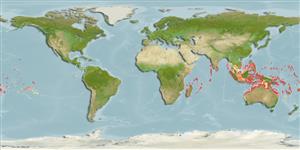Preferred temperature (Ref.
123201): 24.7 - 28.8, mean 27.7 °C (based on 464 cells).
Phylogenetic diversity index (Ref.
82804): PD
50 = 0.5000 [Uniqueness, from 0.5 = low to 2.0 = high].
Bayesian length-weight: a=0.00091 (0.00039 - 0.00215), b=2.99 (2.79 - 3.19), in cm total length, based on LWR estimates for this (Sub)family-body shape (Ref.
93245).
Niveau trophique (Ref.
69278): 3.9 ±0.6 se; based on size and trophs of closest relatives
Résilience (Ref.
120179): Milieu, temps minimum de doublement de population : 1,4 à 4,4 années (Preliminary K or Fecundity.).
Fishing Vulnerability (Ref.
59153): Moderate to high vulnerability (55 of 100).
Nutrients (Ref.
124155): Calcium = 35.3 [19.6, 61.9] mg/100g; Iron = 0.491 [0.298, 1.006] mg/100g; Protein = 18.8 [16.6, 21.4] %; Omega3 = 0.103 [0.048, 0.288] g/100g; Selenium = 43.3 [25.0, 84.9] μg/100g; VitaminA = 48.2 [14.3, 142.9] μg/100g; Zinc = 0.923 [0.668, 1.276] mg/100g (wet weight);
